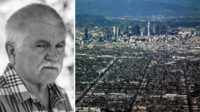Build Nothing and They Will Come

Lebbeus Woods, San Francisco Project: Inhabiting the Quake, Quake City, 1995, graphite and pastel on paper, 14.5 inches by 23 inches

Lebbeus Woods, Photon Kite, from the series Centricity, 1988, graphite on paper, 24 inches by 22 inches

Lebbeus Woods, Unified Urban Field, from the series Centricity, 1987, graphite on paper, 24 inches by 23 inches

Lebbeus Woods, Conflict Space 4, 2006, crayon and acrylic on linen, 74 inches by 120 inches














Lebbeus Woods, San Francisco Project: Inhabiting the Quake, Quake City, 1995, graphite and pastel on paper, 14.5 inches by 23 inches.
Lebbeus Woods, who died last year at age 72, was among the most singularly gifted and stubbornly consistent architects in American history. His fantastically dense drawings in pencil and graphite imagined not just new kinds of buildings?some burrowed into the earth and others floating in the air or through space?but new cities and new worlds. Though he is often connected with the Deconstructivist movement and with architects like Zaha Hadid, Thom Mayne, and Daniel Libeskind, his work also directly recalls earlier figures and precedents in architecture, from Piranesi to Archigram.
If Woods's talent was plain to see, his legacy and what it means for practicing architects remain less so, as a stirring if incomplete new exhibition at the San Francisco Museum of Modern Art makes clear. Organized by Joseph Becker and Jennifer Dunlop Fletcher, assistant curators in the museum's architecture and design department, the show (which runs through June 2) was in the works well before Woods died last fall. It is packed full of examples of his often breathtaking talents as a draftsman and conjurer of alternative architectural universes.
A group of framed drawings from Woods's 1986?87 Centricity series lines one wall just outside the entrance to the exhibition, an appetizer before the visual riches to come. Inside are more framed drawings (dozens of them), models in glass cases, sketchbooks, and snippets of manifestos. Pride of place is given to a brilliant proposal, from 1980, for a monument to Albert Einstein designed to be sent into space, to drift eternally. In drawing equally from technology, philosophy, science fiction, and architectural history?in this case Boull?e's cenotaph for Newton?it is typically dense with allusion. Some of the work on view responds to specific sites and political crises, as in a series of proposals for Sarajevo (1993?94) and Berlin (1990). Other items are more poetic, such as colored-pencil drawings from Woods's 1989 Aerial Paris project.
What the show fails to do?or even try to do, really?is address Woods's complicated relationship with, and tremendous influence on, his architectural peers. We've just emerged from a dizzying and arguably unprecedented period in Western architectural history in which nearly every skilled architect, no matter how adventurous or unorthodox, who wanted to make the jump from drawing to building, or from theory to practice, was able to do so.
Libeskind, Hadid, Mayne, Rem Koolhaas, Wolf Prix?all of Woods's philosophical brethren, the architects he came of age with in the 1970s and '80s?not only took that leap but, after making it, quickly began building on a prolific global scale. Even John Hejduk, like Woods a faculty member at Cooper Union in New York, became a practicing architect in something like the traditional manner.
Only Woods was content to spend his career teaching, writing (often on his own terrific blog), and drawing. Born in Michigan in 1940, he worked early on for Eero Saarinen's office. But by his mid-30s Woods had dedicated himself exclusively to experimental, theoretical projects. Near the end of his life his close friend Steven Holl gave him the chance to design a four-story-tall installation embedded in the facade of Holl's Sliced Porosity Block in Chengdu, China; part sculpture, part dystopian sky deck, Woods's contribution to the building was close in spirit to his sketchbooks.
Beyond that one project, Woods's talent stayed on the page. And this is what makes his career truly unusual. There have always been figures like him in architecture. But he may be the only one who had both the opportunity to build and the will, or maybe just the disposition, to ignore that opportunity with seeming ease over several decades.
The distance that opened up between Woods and his onetime comrades in paper architecture?a distance that only grew over time?is a fascinating chasm to contemplate, to peer into. The SFMOMA exhibition generally pretends it's not there (never mentioning other architects or really exploring Woods's decision not to build), as if the curators were worried that visitors might fall in. But that rabbit hole of a gap promises more revelations?about Woods, and about contemporary architecture?than even this beautiful and deeply rewarding show can provide.
Christopher Hawthorne is the architecture critic of the Los Angeles Times.










